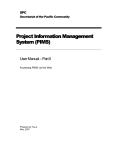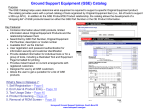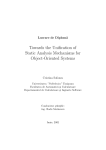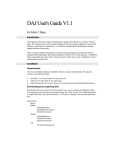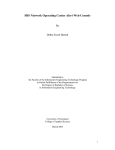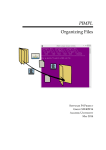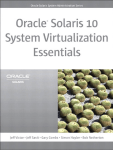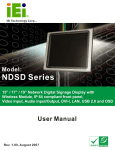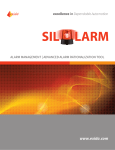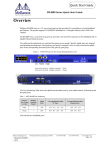Download Team Paper - NIA - Elizabeth City State University
Transcript
1 Implementation of a Static Cluster (April 2009) Vernon Brown Jr., Michael Jefferson Jr., and Chelsea Vick, Students Abstract- The 2008 – 2009 Polar Grid team focused on the permanent installation of a Condor-based test cluster. Network topography, naming schemes, user management, and compatibility concerns were the primary foci of the implementation. The machines targeted were the SunFire V480 management server and several SunBlade 150 workstations as workers all running Solaris 10 as the primary operating system. The Condor High Throughput Computing software was utilized as a scheduler for jobs submitted to the server and then distributed to the workers. I. INTRODUCTION A cluster can be described as a group of interconnected systems working on a job. The 2008-2009 Polar Grid Team goal was to establish a cluster on the campus of Elizabeth City State University, to keep up with the massive amount of data collected. This was initially done to eleven, gently used Sun Microsystems from the University Computer Lab. By adding this cluster, the University will have access to a conveniently placed cluster that will assist in future educational endeavors. It will be tailored to suit the needs of different research teams. In the future, an additional nine computers will be added to this cluster. Index Terms— Cluster, Ubuntu, Condor, Cat 6e V480 we used a closet in Lane Hall. The team was also given the materials to assemble 6e cable. The planning stage was crucial to the project because of time restraints. Therefore, it was necessary to make sure systems were properly labeled to avoid later mix-ups. B. Hardware Issues Once the PCs had been properly connected to the electrical outlet and network connections, the video cards were removed from the Sunsystems. This was done because the video card was not compatible with Ubuntu. First, screwdrivers were used to remove the cover from the CPU followed by the removal of the card. Then the cover was replaced. Once this stage was reached, documentation became essential. We recorded all the steps needed in order to replicate our setup. C. Naming Scheme Every satellite was given a title based upon which IP Address it was assigned. The Sun Systems IP Addresses were numbered from 10.25.4.231-250, as pictured in Figure 1. The PC that had the first IP Address, 10.24.5.231, was given the title of “satellite 1” and so on. Since each user was given administrative rights, the user account was named condoradmin and a unique password was created,sun@122. The hostname was chosen as “Antarctica” for the Sunfire V480. The IP address was 10.40.20.37 II. ROOM SETUP A. Topography First, the cluster size had to be taken into account. There were eleven SunBlade 150s, workers, and one SunFire V480, the managaement server. Additional satellites will be added, so the team allocated space for future expansions as well. Once this observation was made, a space was allocated for where members of the team would perform changes to the systems. Also the area where the cluster would be placed was taken into consideration. The cluster was to be placed in a classroom in Dixon Hall. The room had to two power outlets and five network connections. To optimize the server room, various resources was researched for tips on how to keep the server room secure and effective. For the main server, the sunfire Fig. 1. Three Sun Microsystems labeled with IP Address and names of the satellite. 2 caused by crosstalk and system interference when several wires are transmitting at the same time. E. Cooling The team decided to use the cooling already built into the Microsystem. No additional cooling devices were added. Such devices are known as Computer room air conditionings or CRAC units. CRAC units are used to eliminate downtime of the server room in order for them run proficiently and efficiently. They also are able to protect and extend their investment in information technology systems. With CRAC units, in future expansions upon the project, will be able to reduce capital and operating costs that would, in return, benefit the University. Fig. 2. Members of the team, Michael Jefferson Jr. and Chelsea Vick, assembled Cat 6e networking cables. D. Wiring Using cat 6e cable for the installation, the Polar Grid team developed a test cluster in Dixon Hall, as pictured in Figure 2. Each of the cables had four sets of two wires. Each color set has a transmitting and receiving wire. The team developed a uniform color code. This was to help avoid accidental wiring errors. It was implemented as follows: white orange, orange, white green, blue, white blue, green, white brown, brown. Testing was also vital to making sure it performed as desired. Once arranging the wires, and placing the plastic attachment on the ends, the plastic cover on the wires were crimped. The ends of the cable were inserted into a Multimeter, to make sure the current was flowing properly through the cable. To cut down on accidental wiring we also organized the computers according to their Internet Protocol address. Category 6e cable, commonly referred to as Cat 6e, is a cable standard for Gigabit Ethernet and other network protocols that is backward compatible with the Category 5/5e and Category 3 cable standards. Members of the team used Cat 6e because of the speed of this wire. The cable standard provided performance of up to 250 MHz and was suitable for 1000BASE-T (Gigabit Ethernet). It is expected to suit the 10GBASE-T (10Gigabit Ethernet) standard, although with limitations on length if unshielded Cat 6e cable is used. The printing on the side of the cable housing can easily identify category 6e cable. The cable contains four twisted copper wire pairs, just like earlier copper cable standards. Although Cat 6e is sometimes made with 23 gauge wire, this was not a requirement; the ANSI/TIA-568-B.2-1 specification stated the cable may be made with 22 to 24 American Wire Gauge wire, so long as the cable meets the specified testing standards. Cat 6 connectors are made to higher standards that help reduce noise III. WORKSTATION SET UP A. Install and Configuration Ubuntu is a version of Linux that boasts an open sourcecoding standard that makes it both tailorable to the users specific needs as well as free licensing. In this clustering application of Ubuntu, four packages were installed, the first being OpenSSH. SSh, standing for secure shell, allowed for computers to be remotely accessed. In this cluster, it was commonly used to add and update existing programs over a secure encrypted link. The second package was GNU G++, a compiler that is used to build object code directly from a C programming language program source. The third package was javacc. Javacc was installed to make the programs could be multiplatform. It was imperative this package would be installed since other students and faculty needed it for their project. More importantly, it had the ability to work on multiple platforms. The combination of these three packages were needed for the server to communicate with remote hosts, understand inputted programs and compile source code from the C++ language. However, a number of preexisting programs needed to be updated as well. The apt-get update command was used to assist with searching for sources in which packages can be downloaded. B. Initial Condor Install The installation process began with scrubbing the original inaccessible operating system off of the SunBlade 150’s. We achieved this feat by booting to a command prompt by pressing Stop-A. After getting to the command prompt we then used the “setenv boot-device CDROM dick net” configuring each computer to boot from the Ubuntu cd-rom. 3 The installation process was text based and required little used intervention other than the network configuration settings, the package selection, and partition information. Upon the completion of the installation, a password protected user accounts and began the package installation. Wget was used to download the condor software from the internet. Of the packages installed open ssh if it wasn’t successfully installed during the operating system installation followed by g++, java cc, and lastly we updated everything. This completed the operating system configuration. The most widely used was the sudo command. This was a way to execute commands as an administrator that the average end user could not. Another example of this was nano command. This was a text editor that allowed changes to the hostname of the computer by editing the interfaces. C. Condor Installation Errors Installing condor proved to be a daunting and later impossible task on Ubuntu. There was an incompatibility issue that ran down to machine language. This problem upon further research was one that had been unsolvable so the team resorted to the native operating system installed, Solaris 10. Solaris is a GUI based operating system created by sun systems used to maximize performance in all networking implementations. The installation of Solaris was a simple procedure that involved following several prompts. Once installed, the Solaris10 was not showing up in the pool so the condor_startd process was manually started. To solve this error, the user typed condor_status and the system was added to the pool.This platform has been proven to be fully operational with the condor clustering application D. Final Condor Install and Testing The final step of the cluster installation was to install condor. Condor is a system that enabled computer intensive jobs to be managed and submitted to an idle machine, computer without keyboard activity. This allowed massive amounts of computational information to be analyzed and computed using the available resources of idle computers with user intervention. This technology is called a cluster. A cluster is made up of computers playing one or more of four basic roles; central manager, execute machine, submit machine, and or checkpoint server. The central manager collected information about the computers and directed the negotiation between the submitting computer and the executing computer, this role can only be held by one computer. The execute computer role can be held by any machine and is configured to execute jobs assigned to the computer pool. The submit machine role can also be held by any machine. It is used to forward jobs to the pool. Lastly, the checkpoint server can be set up as any one machine, essentially functioning as a backup. IV. CONCLUSION In summary, the team concluded that the permanent installation of a Condor-based test cluster was a success. But, the implementation must be done on the native Operating System, Solaris. It was found that Ubuntu on a Sun Microsystem with Condor is not compatible. This was evident when the source code compiler produced the error message ”incompatible platform.” This was because the Linux sparc processor was not supported. Solaris, the Java based Graphical User Interface, supported Sparc and X86/64 processors. Moreover, it was compatible with Condor. The network topography was the initial step in this project because space had to be allocated for the members to work in. The naming scheme assisted with proper setup and prevented unnecessary mix-ups. Understanding the user’s needs was part of the user management portion of the project. What proved to be most exigent was the compatibility issues the team faced. This involved the transitioning between the Ubuntu and Solaris platforms. VI. Future Work In future work, the cluster will be significantly expanded once proper configurations are made. Also the team will create a cluster training guide that will aide others in the installation process as well as problems that may be encountered. Furthermore, additional cluster management applications will be added. This will allow more flexibility for other research teams in their projects. The Hub will be substituted for a Switch in the near future as well. The Intranet web status will also be enabled. The team also plans on using a script to start Condor upon start up. As it is now Condor has to be started manually. REFERENCES [1] [2] [3] [4] Parkinson, David. “Protect Equipment and reduce downtime by setting up your server room the right way”. 25 January 2000. 7 April 2009. <http://articles.techrepublic.com.com/5100-10878_111028938.html?tag=hdi> Server Room Cooling Basics. 26 February 2007. 7 April 2009. http://honolulu.hawaii.edu/legacylib/mlahcc.html#internet SunBlade 150 User Manual. Santa Clara, Ca.: Sun Microsystems, Inc.: June 2002. BoilerGrid-Complete User Guide. West Lafayette, In.: Purdue University.: 2008.




